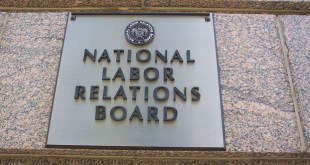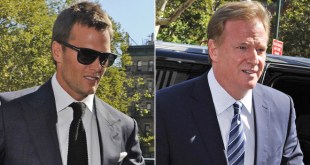Once again New Yorkers have dealt Tom Brady a defeat, only this time the loss wasn’t in a Super Bowl, but a courtroom. On April 25, 2016, the U.S. Court of Appeals for the Second Circuit handed Roger Goodell his long-awaited victory. In a 2-1 decision, the Second Circuit panel held that Roger Goodell did not abuse his authority as arbitrator and reversed Judge Berman’s decision that had vacated Tom Brady’s suspension. For background on how the case developed up to this point, you can read my explanation of Judge Berman’s decision and my discussion of the arguments on appeal.[1]
What the Court Decided
The Second Circuit majority ruled in favor of the NFL on every argument. The opinion frequently either ignored or confused the NFLPA’s points; and, when it did address them it declared them meritless. The panel was composed of three Second Circuit judges: Judge Barrington Parker, Judge Denny Chin, and Chief Judge Robert Katzmann. Judges Parker and Chin voted to reverse Judge Berman, while Chief Judge Katzmann voted to affirm Berman’s decision.
As the NFL argued all along, Judge Parker, writing for the majority, said that Goodell “properly exercised his broad discretion under the collective bargaining agreement and that his procedural rulings were properly grounded in that agreement and did not deprive Brady of fundamental fairness.” From the beginning of this case I have noted the broad deference that courts afford to arbitrators, and the majority found that Goodell’s authority was especially broad, even if his role as judge, jury, and executioner was “somewhat unorthodox.”
On the issue of notice, the majority found that the equipment violation policies (which Judge Berman had found applicable) did not apply to ball deflation because the words “ball,” “tampering,” or “deflation” could not be found in the policies. The majority also found that even if the equipment policy were relevant, the “first offenses will result in fines” language that both the NFLPA and Berman found so relevant were really only minimum punishments that could be exceeded. Berman had found Goodell’s reliance on the league’s PED policy problematic, but the Second Circuit majority chalked it up to merely a bad analogy or poor phrasing, explaining that in any case, such a comparison was still within Goodell’s discretion.
Although the majority attempted to discuss the facts of the case to bolster its deference to Goodell’s decision, it often came across as confused about what actually happened throughout the case. Several times the majority claimed the NFLPA never made arguments that it did or, for example, confused the concept of producing a phone with producing text messages.
The majority also essentially ignored the NFLPA’s argument that Brady was initially punished for “general awareness” of wrongdoing and that Goodell’s confirmation of the punishment shifted the grounds for the punishment without providing him proper notice (including that Brady obstructed the investigation, therefore constituting conduct detrimental to the league). Instead, the majority found that because the initial letter to Brady mentioned his lack of cooperation, he was given proper notice.
On the issues of fundamental fairness, the majority ruled that Goodell acted within his discretion again because he had stated that NFL counsel Jeff Pash’s testimony was irrelevant and because the investigative notes in dispute were not required to be exchanged under the CBA.
After dealing with these issues, some might have expected the Second Circuit to remand the case back to Berman to deal with the issues that he left undecided. Instead, the majority chose to address the other arguments at issue because they were fully briefed and because the majority deemed them “meritless.” The majority dismissed the union’s delegation argument, noting that they likely only raised that argument to receive a more favorable arbitrator. They also dismissed the idea that Goodell was evidently partial or unfair, finding that the NFLPA agreed in the CBA to allow Goodell to be the arbitrator, and now they must abide by his decisions.
In sum, the majority seemed to believe that the NFLPA’s nuanced procedural arguments were indicative of the type of second-guessing that encroaches on the domain of the arbitrator. They believed that Goodell’s actions did not abuse his authority as arbitrator and that they were bound to respect his decisions so long as his reasoning was “barely colorable.”
The Dissent
In his dissent, Chief Judge Katzmann had two problems with the majority opinion. First, he agreed with the NFLPA that Goodell exceeded his authority under the CBA by punishing for conduct detrimental based on considerations that were not used in the original punishment. “Had the Commissioner confined himself to the misconduct originally charged, he may have been persuaded to decrease the punishment initially handed down,” Katzmann wrote.
Second, he found that Goodell’s ignorance of the “highly relevant” policy related to equipment violations that dealt with equipment violations such as stickum, combined with his “inapt analogy” to the NFL’s PED policy led to the conclusion that Goodell had dispensed “his own brand of industrial justice” rather than drawing from the essence of the CBA. This combination led Katzmann to conclude that Goodell’s reasoning was not barely colorable; in fact, Katzmann stated, “I am unable to understand why” Goodell thought this reasoning made sense.
It’s relevant to note that Katzmann did not agree with all of the NFLPA’s arguments, only these two points. However, had another judge on the panel agreed with him, Brady would have been vindicated and it would be the NFL at a loss, suffering yet another legal defeat.
What Happens Next
Now that the Second Circuit has disposed of all the issues in the case, Brady’s initial four-game suspension is confirmed. There are three potential options for Brady now. First, Brady can petition the Second Circuit for a rehearing en banc, requesting that all active judges on the court hear the case. Brady must file that petition within fourteen days of the original Second Circuit panel decision. If the petition is granted, Brady’s suspension will be stayed (meaning he won’t have to serve it) for the duration of the rehearing process, which will take months. Rehearing en banc is rare, and the Second Circuit grants such rehearings even less frequently than other circuit courts. Judge Katzmann’s dissent does increase the chances that the court would grant such a rehearing, but the odds are still low.
If the petition is denied, Brady has a second option: he can request that the U.S Supreme Court review the Second Circuit’s decision. However, this path has an even lower chance of success than a petition for rehearing does. The Supreme Court agrees to hear only about one percent of cases that have requested review, usually only cases that involve significant legal issues or in which circuit courts have reached conflicting decisions. While the NFL may be the king of the sports world, in the field of law a single sports arbitration case is still small potatoes.
The third, and perhaps most likely, option Brady could pursue would be a settlement with the NFL. Brady could agree to forego any further legal action in exchange for a reduced suspension. While a settlement may be more likely than a rehearing en banc of the Supreme Court taking the case, it is still unlikely. The NFL now has all the leverage and would likely condition any reduction of suspension on Brady admitting some guilt. But the whole reason this case was never settled to begin with was that Brady had no desire to admit guilt for participating in a deflation scheme. And even if he were willing to admit guilt, the NFL has already shown that it is willing to spend millions of dollars litigating this case rather than settling - why stop now just to save money on the least likely of appeals?
What This Means for Players and the League
The decision is a huge[2] win for the NFL and completely justifies the league’s interpretation of the CBA. It also ends a string of major legal losses for the NFL: Bountygate, Peterson, Rice, and Hardy cases had all involved reversals of NFL discipline. Now there is even less incentive for the league to change its disciplinary procedures, meaning that the NFLPA will be in a much more difficult negotiating position when the next round of collective bargaining begins.
The decision also sets a significant precedent that the league will rely upon in future conduct detrimental cases: Goodell can do nearly anything he wants in conduct detrimental cases under the broad scope of this opinion. He can make evidentiary rulings adverse to players without satisfactory explanations. He can ignore or misinterpret law of the shop precedent to rule how he wants, even if it is an unprecedented punishment. He can even change the basis of punishment on appeal and confirm player punishments on alternative grounds.
Moreover, the league now has appellate court precedent in its home jurisdiction on these issues, including a ruling that gives no weight to the NFLPA’s frequent argument that he is an evidently partial arbitrator. Perhaps most harmful in the NFLPA’s mind is that the Second Circuit rejected Judge Berman’s analysis that specific provisions govern over more general ones. In essence, it does not matter whether there are other CBA provisions which might lay out specific ways to handle certain actions as long as Goodell finds such actions to be conduct detrimental and chooses to punish using his Article 46 power.
While this decision was also an implicit rebuke to Berman, the thrust of majority’s arguments was aimed squarely at the NFLPA. Parker repeatedly went out of his way to criticize the NFLPA’s strategy on appeal and handling of the arguments. However, don’t expect the NFLPA to stop litigating these issues going forward. The union has still won a series of decisions vacating or reducing the league’s punishments in high-profile cases. Even in this case, the NFLPA won before Berman and managed to get a 2-1 decision on appeal. To put it another way, of the four judges who looked at the case, two of them sided with the union. No doubt Brady and the NFLPA are left wondering, what if a different judge had been on the panel instead of Chin or Parker? Maybe that other judge would have sided with Katzmann. So in one sense, the NFLPA still has reason to feel hopeful about its future legal chances.
In another sense, the NFLPA really has no choice but to litigate future cases similar to Brady’s. It is stuck with a CBA that affords players very little due process, and what procedural protections they do receive are subject to the Goodell’s decision-making. Barring a joint agreement from the NFL and the NFLPA to change the league’s disciplinary procedures, the NFLPA’s best path may be to continue using the legal system as a method of checking back the broad powers they allowed Goodell to retain during the last CBA negotiations.
While the Second Circuit’s decision likely provides some closure on Brady’s situation next season, the player discipline war between the NFL and NFLPA will undoubtedly continue in courtrooms around the country.
[1] You can access all of the major legal documents of the case on our Deflategate Legal Filings page.
 The Sports Esquires Putting Sports on Trial
The Sports Esquires Putting Sports on Trial



One comment
Pingback: Sports Law Links - The Sports Esquires